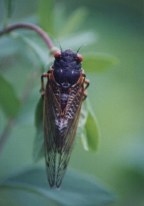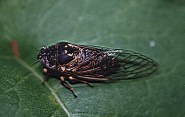Great Lakes Cicada Page | home
Introducing the Cicada | Life Cycle | 1999 Brood V Account | My Journeys | Magicicada Galleries | Magicicada Gallery 2 | Magicicada Nymphs | Chimneys & Emergence Holes | Magicicada Emergence | Magicicada Emergence 2 | Magicicadas Feeding | Magicicada Mating | Magicicada Ovipositing | Eggs & Egg Damage | Cicada Mortality | Brood Maps | Tibicen Galleries | Tibicen Gallery 2 | Tibicen Nymphs | Tibicen Emergence | Tibicen Emergence 2 | Tibicen Feeding & Ovipositing | Okanagana Galleries | Field Guide | How to Find | Deterrence | Armed Robbery??? | My Story | About Me | Cicada Links | The Future
Field Guide
Here's an easy reference guide you can print out if you encounter a cicada in the Great Lakes region.
 Cicada ("Si-Kay-Duh")
Cicada ("Si-Kay-Duh")Common Name: Periodical Cicada Scientific Name: Magicicada
Aliases: 13 or 17 Year Cicada; 13 or 17 Year Locust; Satan's Parakeets
Size: 1" to 1 1/2" inches
Occurrence: Early Summer. Mid-May to Mid-July (Northern areas)
Mid-April to Mid-June (Southern areas - 13 year species)
Range: Eastern U.S. - West to Iowa & Texas
Habitat: Deciduous Forests - prefers forest edges. Seldom occupies urban dwellings.
Characteristics: Appear every 13 or 17 years in enormous numbers to satiate predators. Males congregate to form loud mating choruses that can be deafening. Females deposit eggs in the twigs of tree, often killing the host branches.
Distinguishing Marks: Red eyes, black bodies, orangish wing veins & legs, "W" shape on fore wings.
_________________________________________________

Common Name: Dog Day Cicada
Scientific Name: Tibicen
Aliases: Locusts, Harvest Flies, Annual Cicada
Size: 1 1/2" to 2 1/2" inches
Occurrence: Mid to late Summer. Appears in late June through early September and often into October.
Range: Throughout the U.S. & Southern Canada.
Habitat: Pines, Conifer, & Deciduous Forests. Inhabits rural & urban areas & city parks.
Characteristics: Seldom appears in large numbers. Males produce a loud buzz like sound. They are quick to take flight if threatened. Other habits are similar to the Magicicada.
Distinguishing Marks: Robust black bodies with whitish undersides. Body & wing veins are often decorated in green, brown, & gray colors.
 _______________________________________________________
_______________________________________________________Common Name: None designated. Often mistaken for the Periodical Cicada.
Scientific Name: Okanagana
Aliases: Locusts (Again, often mistaken for the Periodical Cicada)
Size: 1" to 1 1/4" inches
Range: Central to Western U.S. & Southern Canada. Some species are desert dwellers.
Habitat: Deciduous Forests
Occurrence: Early Summer - Late May through Mid-July.
Characteristics: Can sometimes appear in large numbers. Habits are similar to Tibicens.
Distinguishing Marks: Black bodies with orangish (sometimes reddish) or beige undersides & legs. Bodies have similar markings like the Tibicens but with different colors.
Photo information: 1. Magicicada - taken 06/99: F.A. Seiberling Naturealm, Summit County, Ohio
2. Tibicen - taken 08/2000: Fremont, Sandusky County, Ohio
3. Okanagana - taken 06/98: St. Ignace, Mackinac County, Michigan